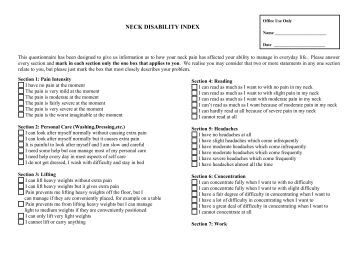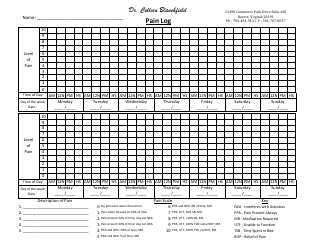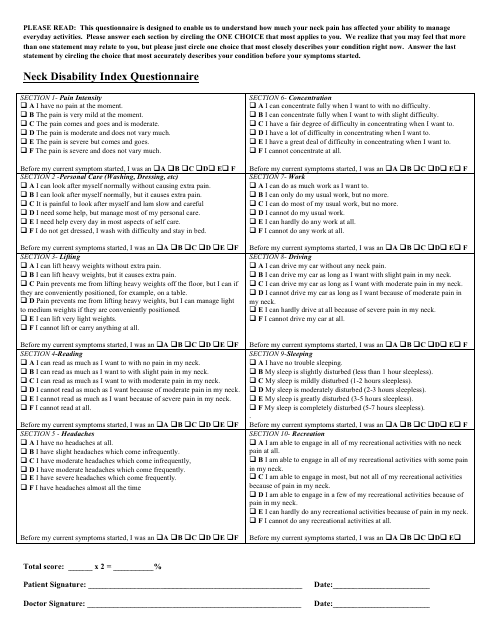- Neck Disability Index Spanish Pdf
- Shoulder Disability Index
- Spanish Ndi Pdf
- Neck Index In Spanish Printable
- Neck Index In Spanish
The Neck Disability Index (NDI) (modification of the Oswestry Low Back Pain Disability Index). Patient-completed, condition-specific functional status questionnaire with 10 items including pain, personal care, lifting, reading, headaches, concentration, work, driving, sleeping and recreation. Roland Morris Disability Questionnaire Translations. Translations are generally provided as Word files. Where there are unusual symbols, pdf files are provided. Neck Disability Index In Spanish Results. A single factor explained 51.6% of the variance, the Cronbach alpha score was 0.89, the intraclass correlation coefficient was 0.98, the Pearson correlation coefficient with pain visual analogue scale was r = 0.65 and with Northwick Park Neck Pain Questionnaire was r =.
Neck Disability Index. This questionnaire is designed to help us better understand how your neck pain affects your ability to manage everyday life activities. Please mark in each section the. That applies to you. Although you may consider that two of the statements in any one section relate to you, please check the bos that. Roland Morris Disability Questionnaire Translations. Translations are generally provided as Word files. Where there are unusual symbols, pdf files are provided.
How does the neck disability index (NDI) calculator work?
This is a health tool that evaluates the effect cervical spine neck pain has had on the subject in terms of lifestyle day to day activities.
The NDI is based upon the Oswestry Low Back Pain Disability Index and is a self report condition specific questionnaire. The 10 items addressing functional status are listed below.

■ Pain Intensity - pain occurrence and perceived severity;
■ Personal Care (Washing, Dressing etc.) – ability to care for oneself and degree of perceived accuracy in doing so;
■ Lifting – capacity to lift different weights and pain occurrence while doing so;
■ Reading – degree of experienced pain in the neck during and in different reading positions;
■ Headache – frequency and perceived severity of recurrent headaches;
■ Concentration – degree of difficulty in concentration;
■ Work – comparison between past and actual work capacity;

■ Driving – ability to drive and length of time to drive before pain starts;
■ Sleeping – quantifies sleep disturbance in terms of time;
■ Recreation – perceived impairment to partaking in leisure activities.
Each of them comprises of 5 answer choices, varying in severity of pain or degree of movement, activity impairment from A to F. Therefore choice A carries 0 points while question F weighs 5 points.
Nowadays the neck disability index is one of the most used measures for neck pain and has been translated in several languages. Going through the questionnaire should take between 2 to 9 minutes with mean duration values in the studies placed between 3 and 7.8 minutes.
After the original study in 1991, several validation studies have ensued with different reliability outcomes.
The neck disability index (NDI) calculator can be used to evaluate current status but also to monitor disability evolution or response to treatment. Current recommendation suggest the tool to be used at baseline and then fortnightly for monitoring purposes.

However, it appears that a change of at least 5 points in most conditions or 10 in mechanical neck pain and 13 in cervical radiculopathy, can be recognized as clinically meaningful. During recovery patients usually score between 5 to 20 overall in the disability status.
The NDI testing resulted in a fair to moderate test-retest reliability in patients with mechanical neck pain but also for patients with cervical radiculopathy .
Also the following populations have been tested:
■ Cervical radiculopathy;
■ Neck pain: Chronic, non-specific;
■ Neck pain: Chronic, non-traumatic;
■ Neck pain: Chronic, uncomplicated;
■ Neck pain: Degenerative, post-traumatic and other;
■ Neck pain: Mechanical;
■ Neck pain: With or without arm pain.
Therefore the tool is seen as valid in evaluating neck pain and outcomes in patients with either acute or chronic conditions, whiplash associated conditions as well as musculoskeletal dysfunctions.

Neck Disability Index Spanish Pdf
NDI score interpretation
As explained above, each of the 10 items consists of 5 answer choices with points from 0 to 5. This means that the overall score range is between 0 and 50, 0 being no to little pain and discomfort while 50 being the severest degree of pain and disability with complete activity limitation.
The score is sometimes expressed in percentage as well. The higher the score, the higher the perceived impairment in this disability rating scale for neck injuries.
Shoulder Disability Index
Although the original study does not provide specific benchmarks or cut off points, there are several interpretations available, although not completely validated, such as that of Vernon and Moir, described below:
■ 0-4 points (0-8%) no disability;
■ 5-14 points ( 10 – 28%) mild disability;
■15-24 points (30-48% ) moderate disability;
■ 25-34 points (50- 64%) severe disability;
■ 35-50 points (70-100%) complete disability.
References
Spanish Ndi Pdf
1) Vernon H, Mior S. (1991) The Neck Disability Index: a study of reliability and validity. J Manipulative Physiol Ther; 14(7):409-15.
2) Cleland JA, Childs JD, Whitman JM. (2008) Psychometric properties of the Neck Disability Index and Numeric Pain Rating Scale in patients with mechanical neck pain. Arch Phys Med Rehabil; 89(1):69-74.
3) Cleland JA, Fritz JM, Whitman JM, Palmer JA. (2006) The reliability and construct validity of the Neck Disability Index and patient specific functional scale in patients with cervical radiculopathy. Spine (Phila Pa 1976); 31(5):598-602.
Neck Index In Spanish Printable
4) Hogg-Johnson S. (2009) Differences in reported psychometric properties of the Neck Disability Index: patient population or choice of methods? Spine J; 9(10):854-6.



